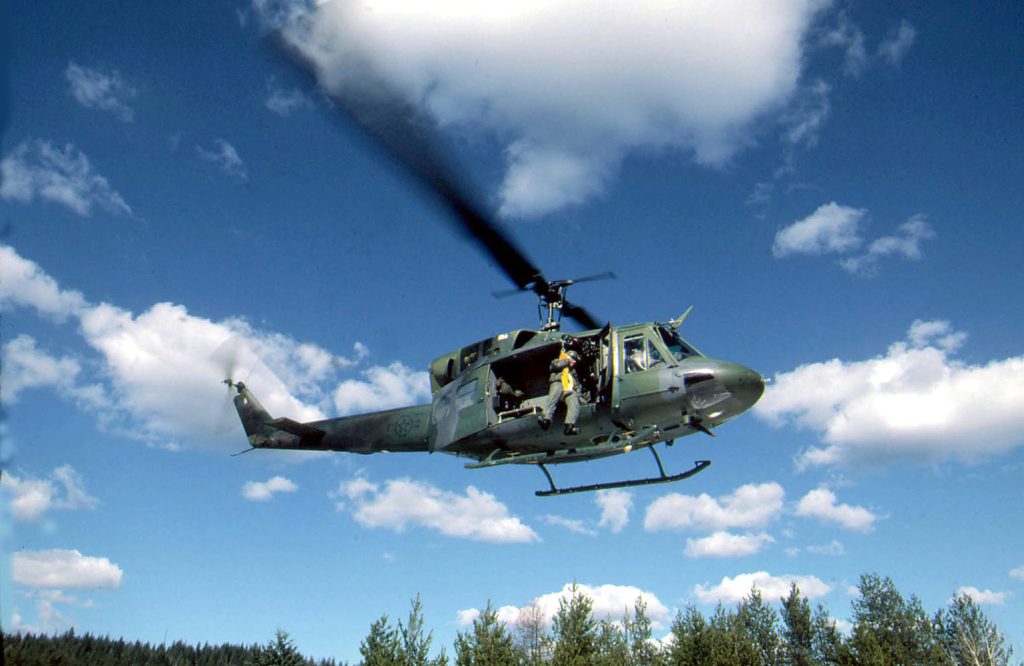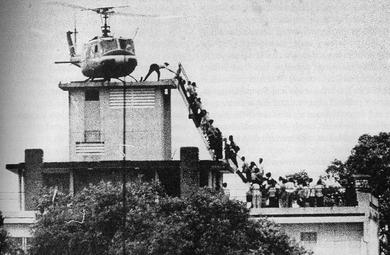The Sound and Fury of the Huey Helicopter
What is the most iconic military vehicle ever created? For both visual and acoustic reasons, I’d suggest it’s the Huey helicopter of the Vietnam War era.
World War I gave us biplanes for the first time, World War II and the Korean War gave us the Jeep—now part of American pop and recreational culture—and the Iraq and Afghanistan wars gave us Predator drones. But nothing tops the Huey, if you ask me.
Visually, the helicopter looks vaguely like a dragonfly, a grasshopper, or some other large insect with big eyes. Painted black or dark green, it is frighteningly utilitarian, if not sinister.
Acoustically, the rhythmic, thumping sound of a Huey is primal and tantalizing, and iconic in and of itself. For injured or trapped U.S. soldiers in Vietnam, the sound communicated the promise of rescue and transport to safety, and was therefore inspirational and heroic. On the other hand, for the North Vietnamese soldiers who were on the receiving end of an attack, the sound would’ve been insidious and demonic. Ground-based American medical personnel often had mixed feelings about the sound, for it often meant that new casualties were being transported back from the front lines.
Formally known as the Bell UH-1 Iroquois Helicopter (originally the HU-1, hence the nickname), the Huey was first flown during training exercises in 1956 as a medical evacuation and general utility helicopter for the U.S. Army. During the Vietnam War, its role expanded greatly to include search-and-rescue operations, troop transport, disaster response, firefighting, cargo transport, and special operations. Officially, a total of 7,013 Hueys were used in Vietnam; 3,305 of them were destroyed, leading to the deaths of over 2,700 pilots, crew members, and passengers.
The Huey has been made famous by its prominent role in Hollywood films, from Francis Ford Coppola’s award-winning classic Apocalypse Now (1979) to Platoon (1986) and Full Metal Jacket (1987) among many others. Indeed, the vehicle has become synonymous with the Vietnam War.
Direct U.S. military involvement in Vietnam officially ended on August 15, 1973, just before I turned 9. I was too young to understand much about the war, and frankly, I don’t remember anything special about that date. But 10 years later I had a personal encounter with a Huey, and I’ve not forgotten it.
On July 20, 1983, the Museum of Science and Industry in Chicago held an outdoor festival to celebrate its 50th anniversary. I was a tour guide, a position I had held for nearly two years. Most days, I worked at the information desk, giving driving directions and pointing out the cafeteria or nearest restroom to harried guests. Other days I worked in the famous Coal Mine exhibit, replete with working equipment and a passenger train, where we offered tours to up to 2,000 people on busy days.
Given the repetition involved in our daily tasks, I jumped at the chance to work outside at the festival. I knew full well I would be working in the heat of a Chicago summer in my standard, museum-issue formal uniform—white, short-sleeve dress shirt, blue necktie, navy blue slacks, and dress shoes. It didn’t matter. A little heat-induced sweat was a small price to pay for the chance to break the tedium of yet another day inside.
I was assigned to guard a Huey helicopter that was displayed by the U.S. Army. To my surprise, a lot of visitors asked me if I was the pilot. I never had any desire to join the military and didn’t think I would ever be mistaken for a military man. That said, I was two months shy of my 19th birthday. I played a lot of soccer and was in great shape. I had an anomalously short haircut given that it was 1983 and big hair was all the rage. I wore aviator-style Ray-Ban sunglasses (who didn’t?). And I was wearing an uncomfortable dress uniform outside, in 90 percent relative humidity and Chicago heat. Looking back through the mists of time, their question seems a bit less preposterous.
I remember chatting briefly with the pilot, who allowed me to sit in the back of the aircraft. All of the seats had been removed, and I noticed tiny ringlets, not much bigger than the width of a man’s index finger, recessed into the floor. I asked what they were for. “Handles,” the pilot nonchalantly replied. “For cargo?” I asked. He nodded, “And for people.” I was astounded. How could a soldier, fully loaded with gear, reasonably expect to hold on to an aircraft with just a finger or two? Rough going, I guess. On the flip side, how could such an aircraft have reasonably served as a medical evacuation vehicle? Then it hit me—I realized the emphasis was on “evacuation” more than “medical.” A flying ambulance, it wasn’t.
On April 30, 1975, Saigon fell to the North Vietnamese army, marking the strategic, tactical, and symbolic end to the Vietnam War. For many North Vietnamese, it was the happiest day of their lives. Firmly ensconced in Chicago, I remember the day well, and I remember being torn. I was happy that the war was over but sad, as any fourth-grader would be, that we Americans had indeed finally and conclusively lost.
More starkly, I remember seeing around that time a photograph of a Huey and a line of desperate people making a last-ditch effort to flee Saigon on April 29. Some two dozen people are easily visible in the photograph. They push up a staircase leading from an otherwise nondescript rooftop to the top of a small utility room. A lone Huey rests precariously on the roof of that utility room, which is clearly not a landing pad. Someone, perhaps an American military man, pushes on the lead person, trying to get him to retreat.
As it turned out, the Huey in the photo was one of many helicopters involved in the U.S. evacuation of Saigon, dubbed Operation Frequent Wind. It has been called the largest helicopter evacuation ever. In less than 24 hours, around 80 helicopters ferried more than 7,000 Americans and South Vietnamese out of Saigon to ships waiting offshore. We have no way of knowing how many people didn’t make it out.
I thought I had come to terms with the harshness of war and the fact that people die and get injured. But I know I hadn’t yet come to terms with the fact that desperate civilians frequently get left behind, often in large numbers.
I now know that even if they used all the ringlets on the floor of that Huey, it could at best take about 15 people at a time. Even with all the Hueys and other helicopters waiting in the wings, there were just too many people in the city to rescue. The majority of them were out of luck. I wonder when they finally knew it. I wonder how they felt hearing the rhythmic “whoomp, whoomp, whoomp” of the last helicopter fading off into the distance, taking with it their last chance at freedom. The finality of it all is heartbreaking.
As Operation Frequent Wind wound down, some of the Hueys and other helicopters had to be jettisoned or ditched in the sea after making it safely to waiting American Navy ships—they took up space that was needed to continue the evacuation. In a sad twist on the famous image from World War II, in which victorious U.S. military personnel struggle to raise a flag on the newly controlled island of Iwo Jima, another famous Huey photograph shows Navy personnel pushing a perfectly good helicopter off a ship’s flight deck and into the ocean.
Hope, like an icon, can sink like a stone.

































